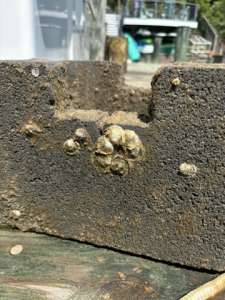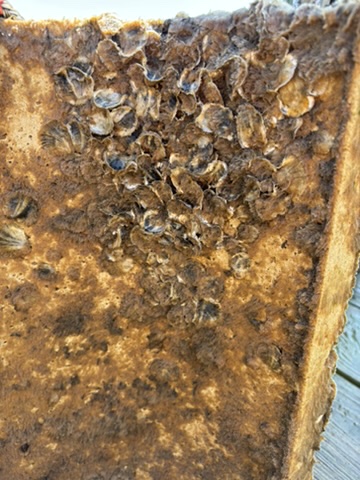Olivia ’25 experiments with different forms to help grow the oyster population in the Chesapeake Bay partnering with the Chesapeake Bay Foundation.
Over this summer, I have been researching, creating, and experimenting with different concrete forms to help grow the number of oysters in the Chesapeake Bay. I have simultaneously been volunteering with the Chesapeake Bay Foundation’s oyster team every week. They helped me with my research and have been essential to my project. The people there taught me so much about what goes into oyster restoration and research. Once I used their tanks to seed my nine concrete forms with oyster spat, I monitored over the course of a month. My ultimate goal is to find the best, most efficient, and easily reproducible structure that will make it easy for anyone with access to the bay to help grow oysters and become a part of restoring the Chesapeake Bay. I will include the results of the three different types of forms below.
Semi-Circles:
The semi-circle forms have the best results overall. The average size of the oysters at the end of the summer was around 2.3cm, and the range was around 1.5-3.3cm. The oysters on these forms have grown the most over these four weeks. The structure had less algae growth on it because it sat higher in the water column. The textured side especially is easy to hose off, which makes it simple to maintain and keeps the oysters healthier. These forms are also super easy to install. My worry with this form is that many of the oysters grew on the inside of the semi-circle, which could damage them, especially in areas with lots of waves that would cause the form to repeatedly knock into the piling. The oysters on these forms are also tightly clumped together, forcing them to compete for space. After talking with Hyde Concrete again, they confirmed that we could make a mold for these forms, and easily replicate them on a mass scale, but first I plan to make some changes to it.
Tiki Torches:
The tiki torches worked well, but they had the least surface area and the oysters were slightly smaller on average compared to the semi-circles. The average oyster size was around 2cm and the range was about 1-3cm. They are the hardest of the three forms to replicate, but there were no problems with crowding. They are harder to implement, so to monitor them this summer, I tied them to strings and hung them off my dock. Over this next week, I will place them in the mud as intended, so I can observe how easy they are to put in place and manage. I am worried that they may not settle well in the mud because of the buoyancy of the bamboo. They could also be easily displaced and drift to shore, where the oysters would suffocate in the mud.
Castles:
Although I intended the castle forms as my control study, they were the least successful of the three forms. The average size of the oysters was only about 1.5cm and the range was about 0.5-2.5cm. They are mass-produced by a concrete company I worked with and are used all across the East Coast. However, the algae growth on the forms has been significant, and they are the most difficult to clean. The oysters did not seed well, and the few oysters on the form are much smaller than on the other forms. The concrete even started falling apart the last time I hosed them off. I tied the castles to ropes so I could pull them up and study them, but if I were to use them as intended, by leaving them on the bay floor, the oysters would likely die or be severely stunted from the amount of mud and algae. This result was surprising, but it has only solidified my resolve to do more research and improve on what are considered the best forms today.
Even though the oysters have grown well on the semi-circle forms, I plan to conduct more research this year and next summer about the materials and shape of the concrete structures. I want to do small tests with different concrete mixtures because, as shown with the castles, the material of the concrete impacts the oysters’ abilities to settle and grow. The main problem with the semi-circles was that the oysters settled on the inside of the form and could be damaged by knocking into the dock pilings. I plan to test out semi-circles where I build stoppers on the top and bottom of the inside of the form to prevent the oysters from knocking into the piling. I am also experimenting with the idea of a cover to go over the form to prevent oysters from settling on the inside. I want to thank the Chesapeake Bay Foundation, Hyde Concrete, and Allied Concrete. They have been extremely generous and are a fundamental part of this project. I am excited to continue my research with them over the next year.










